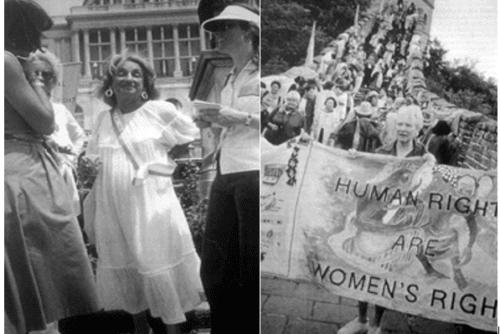What is “Postfeminism” and Are We In It?
There is little debate that we are no longer in the period of Second Wave Feminism. Its origins are easier to establish than its demise, since 1970 marked an explosion of feminist theoretical books that have since defined the movement conceptually. Kate Millett’s Sexual Politics, Shulamith Firestone’s The Dialectic of Sex, and Robin Morgan’s Sisterhood is Powerful were all published that year, as was Germaine Greer’s The Female Eunuch in Britain. Postfeminism began to appear as a term in the media by the mid-1980s, but perhaps began to be significantly present as a concept in 1991 when Susan Faludi published Backlash: The Undeclared War Against Women. This book acknowledged the concept and from a feminist point of view, tried to dispel it as a media-inspired attitude that feminism was passé because women had arrived at their goals, while the truth was that a massive mainstream defense of the status quo was producing the ideology of postfeminism. Slowly, however, this situation gave way to several highly articulate anti-feminist but assertive independent women who, in the early 1990s, attacked feminism and/or proclaimed postfeminism as appropriate and established. I’m thinking especially of Camille Paglia, Rene Denfeld, and Katie Roiphe. Several of these women claimed to speak from within a position informed by or at least sympathetic to feminism, so their criticisms were harder to dismiss. Typical would be someone like Naomi Wolf whose first book in 1990, The Beauty Myth, is a familiar analysis of how women are coerced by society to pursue the beauty ideal. However, her second book, Fire With Fire, moves to call for “power feminism” that rejects an old bad feminist “hardline” for a kind of “seize the day” program that claims equality and economic empowerment are attainable for women with enough drive and self-confidence. Rather than parsing these arguments in detail, what I would observe is that as more women entered into the discourse of postfeminism from an ambiguous position (claiming to be within feminism on the one hand and calling for a move beyond it on the other) the rhetoric of postfeminism and the public perception that we are in it steadily increased. A pro-feminist book recently published, The Routledge Critical Dictionary of Feminism and Postfeminism, instantiates postfeminism in its title, even while arguing that looking to a “third wave feminism” may be better because it “stands on the shoulders of other, earlier, feminist movements” (54). My conclusion, however, is that avoiding “postfeminism” is impossible and unproductive, and that there will be no “third wave” until a genuine popular movement with political objectives is visible on the horizon, and unfortunately, it’s not yet discernable.
So in answer to the second part of the question first, “Yes” we are in Postfeminism. What is it exactly? It is a time when the residue of feminism is still with us in terms of its history and some of its commitments, but without the overarching umbrella of an organized social or political movement at either grass roots or national levels. (I will primarily be speaking here about the U.S., and sometimes about the U.K.) This does not mean that local, grass roots groups and political campaigns do not exist, but the identification of women with a Movement has virtually vanished. Some lesbian and queer women identify with the gay/lesbian/queer Movement, which still has some identifiable status as a Movement, but the relation between feminism and this movement is itself historically troubled and in no case is the assumption of a cross-over justified today. NOW, the National Organization for Women, is just another political pressure group, and while not irrelevant to national politics in the U.S. it is extremely weak and disunified.
Secondly, the lack of identity of the term “woman,” so well interrogated by the intellectuals of the Second Wave, has meant that there is not an umbrella term under which particular women can identify and organize. Not only the critique of someone like Julia Kristeva who taught us that “Woman” is a cipher under which real women cannot find a place, but also the concrete criticisms of women of color and lesbians that white liberal heterosexual women were claiming to speak for them erroneously, and the cultural ethnocentrism of first-world feminists have meant that by the mid 1990s, feminism had a hard time forming a focal point because identifying with any common properties held by all women seemed impossible. The desire for a unified subject of feminism was finally part of what held the feminist movement back. Even if many feminists mourn the loss of shared ideals about what is possible, this is a different thing than mourning the loss of a narrow ideal of what woman is or women are.
Third, some of the criticisms of second wave feminism persuaded young women that feminism was old fashioned or too rigid. For example, the charge of extremism, that feminism had become old fashioned and intolerant in upholding in Denfeld’s words, “a moral and spiritual crusade that would take us back to a time worse than our mother’s day – back to the nineteenth-century values of sexual morality, spiritual purity, and political helplessness . . . current feminism would create the very same morally pure yet helplessly martyred role that women suffered from a century ago” (46-47). The reference here is to campaigns against sexual harassment, date rape, and pornography, associated with some forms of feminism. Along the same lines, Denfeld, Roiphe and Wolf also claim that feminism has portrayed women as victims and that this is self-defeating and untrue. These arguments against a perceived puritanical morality and a culture of victimization are persuasive in contemporary American culture because of their intersections with certain entrenched traditions of libertarianism and self-sufficiency. Having a long history of American Puritanism in its past, there is also an impassioned commitment to personal freedom and first amendment rights shared by significant constituencies on the left and also on the right of the political spectrum. This phenomenon has produced odd allegiances between right-wing Christian groups and feminists on some issues like pornography, and has alienated the more libertarian feminists or gay/lesbian/bisexual feminists for whom the struggle for sexual freedom has been the highest priority.
As for the discourse of victimization, it must be seen against a larger U.S. tapestry of social injustice for poor, non-white people across society. How can middle-class women claim the status of victim when compared to the homeless or otherwise downtrodden? However, on the other hand, conservative politicians have successfully overthrown the appeal to injustice by treating victims as those who should be held responsible for their situation, and have recoded “victim” as a term only appropriately belonging to victims of crime. In death penalty arguments in the United States, one argument of the pro-death penalty people is that the victims have a right to witness the retribution for their injuries in the form of execution. Thus the rhetoric of victims and victimization is highly volatile in the U.S. No one wants to be a victim, but if one is, retribution is the desired outcome. This complicates and strengthens the perception that feminists indulge in an unwarranted discourse of victimization.
These things, then, the lack of an energetic and robust political movement, the lack of an identity “woman” with which to align, and the perception of restrictive and detrimental positions associated with feminism have contributed to bring about a state of postfeminism, a state in which there is nothing to join and no clear “woman” to be, but in which many of the concerns of actual women about equality, free expression, power, respect, and sexual subjectivity are still present and compelling. This is what I have earlier called the feminist residue from the Second Wave – these concerns have been identified and are still present, but it is more difficult to figure out how to tackle them. Is there a way to harness the energies from Second Wave feminism to intervene in the current situation in a new form? Perhaps, but let us first now turn directly to performance.



